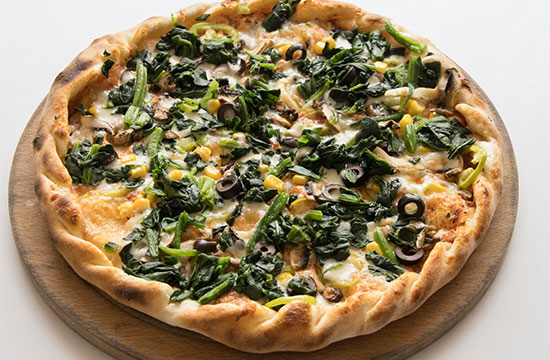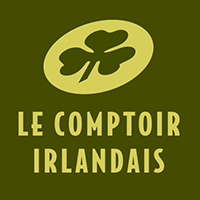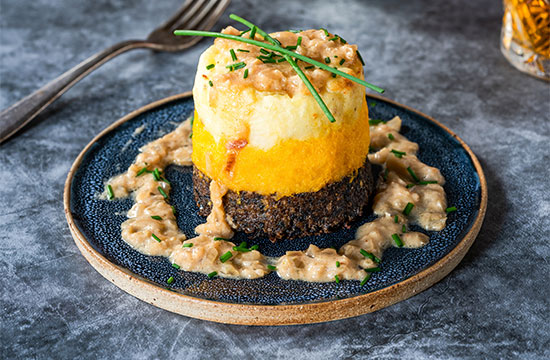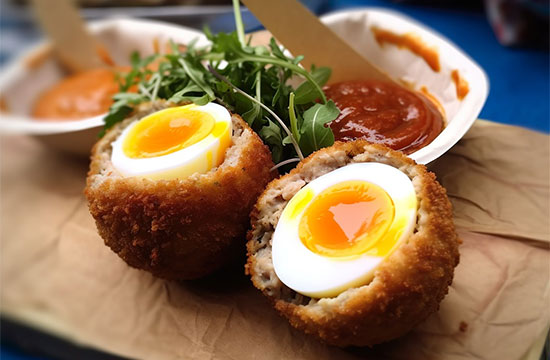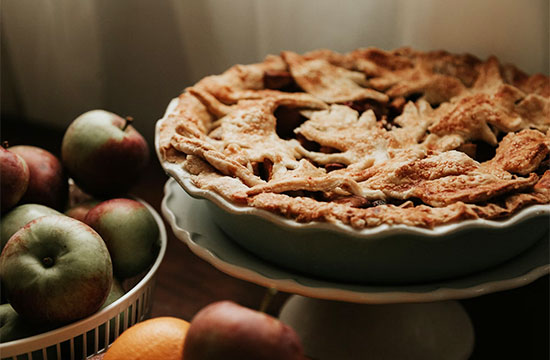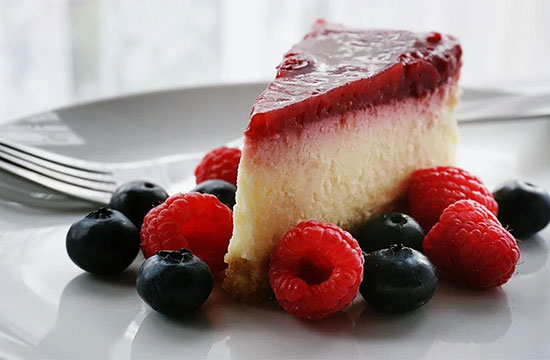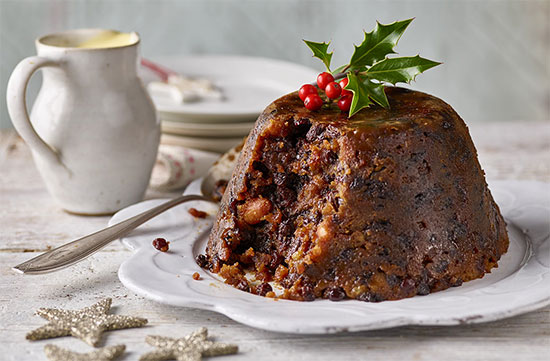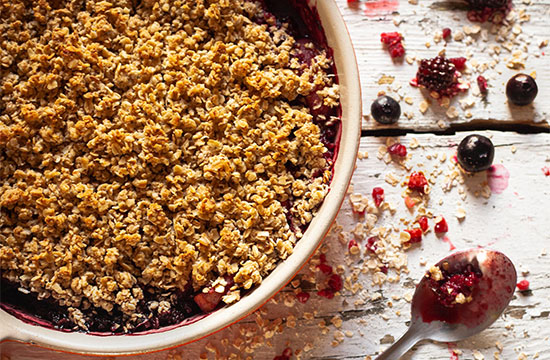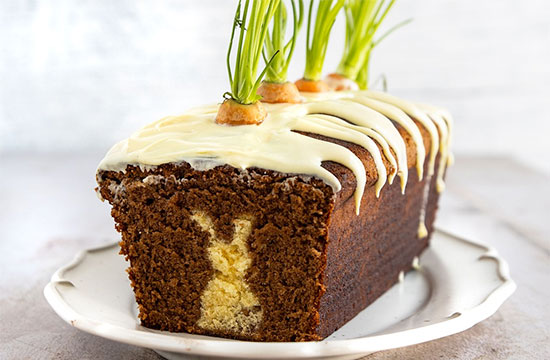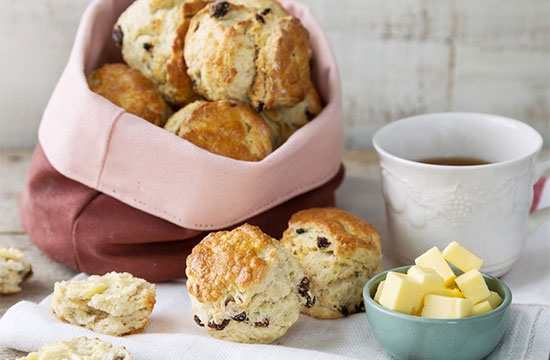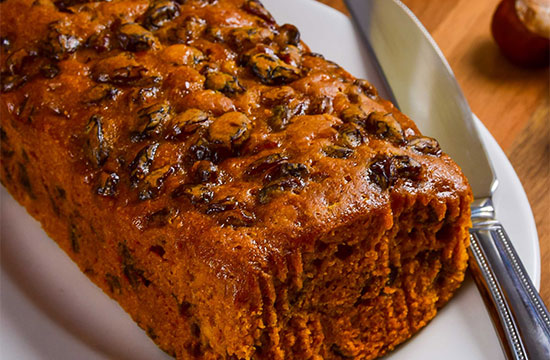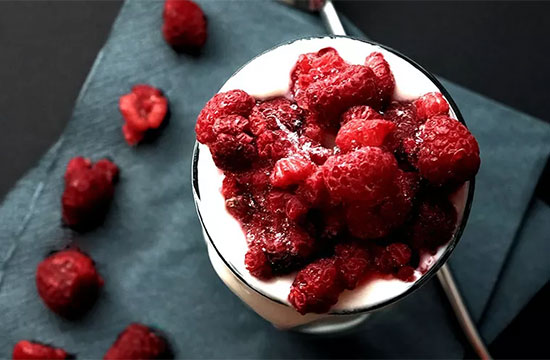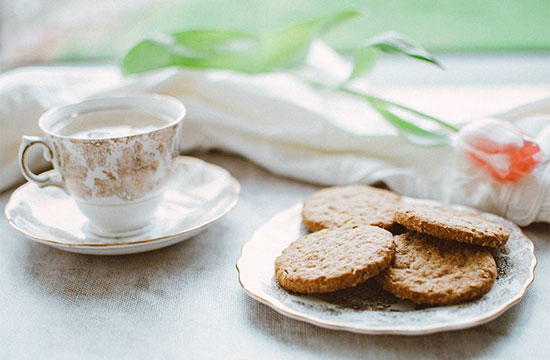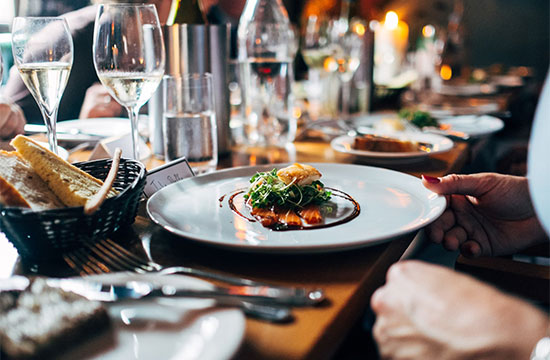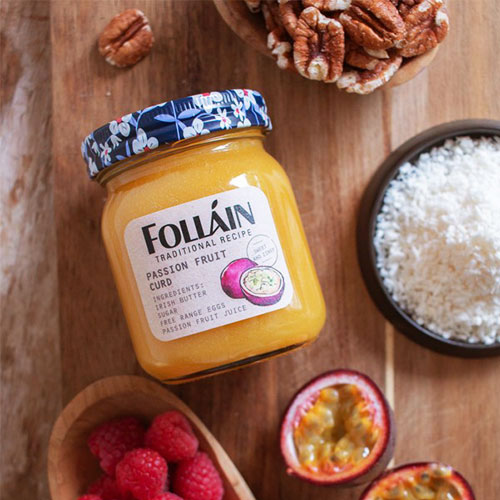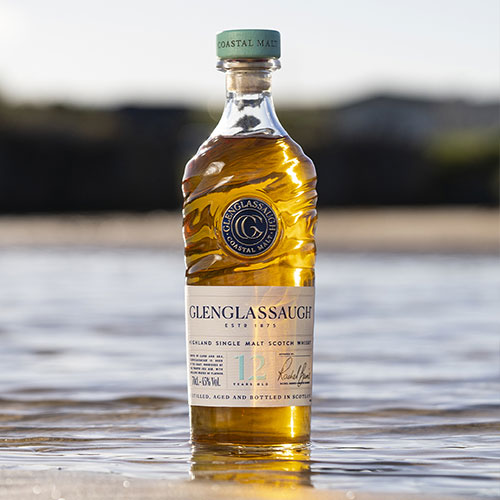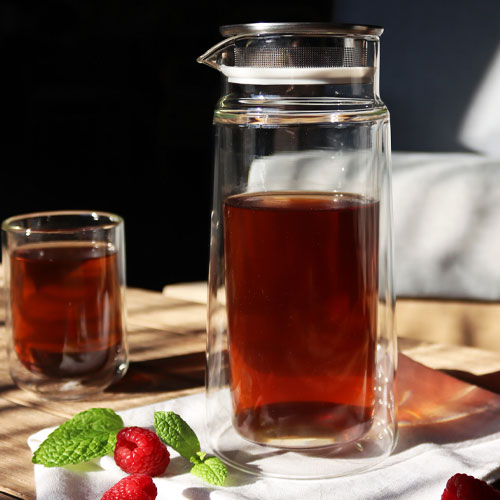Typical British and Irish dishes
Traditional breakfasts
English Breakfast: The famous and no less hearty "Full English breakfast", also called 'fry-up', has now become an integral part of English gastronomy. Far from our French breakfasts based on bread, cereals or pastries, The Full Breakfast consists of sausages, bacon, eggs, tomatoes, mushrooms, black pudding, all accompanied by toast, marmalade and of course, a good English tea. It's impossible not to come out with a full stomach!
Irish Breakfast: The Irish breakfast, also called "Ulster fry" in Northern Ireland, strongly resembles its English cousin, with the difference that it is accompanied by the famous soda bread, this bread made from baking soda which is very popular in Ireland, and also includes white pudding and potato farls. Top it off with butter, marmalade and Irish tea, and you're ready to face the harshest of days, just like the Irish fishermen for whom this solid breakfast was originally intended.
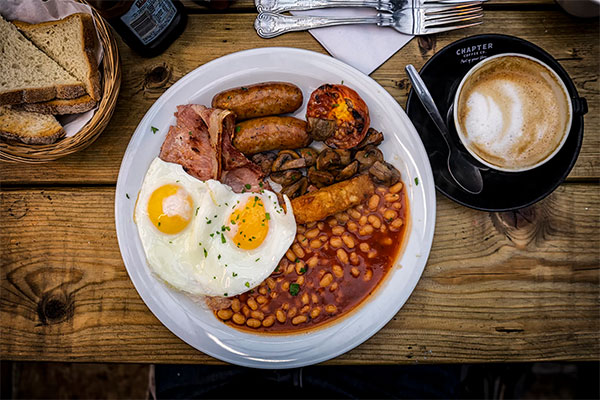
Welsh Breakfast: The Welsh breakfast includes most of the ingredients of the English Breakfast to which are added two typical - and equally surprising - products from Wales: laverbread, a preparation made from seaweed, or even cockles, these small shellfish abundant on the British coast. A surprising breakfast with smooth marine flavours, which provided their daily dose of nutrients to the miners of Wales in the 1800s.
Scottish Breakfast: The Scottish breakfast is also inspired by the English Breakfast, including typically Scottish products: haggis, a dish made from meat and oats that needs no introduction, "Lorne sausage", a traditional square-shaped sausage, and Tattie scones, a kind of potato pancake that the Scots love.
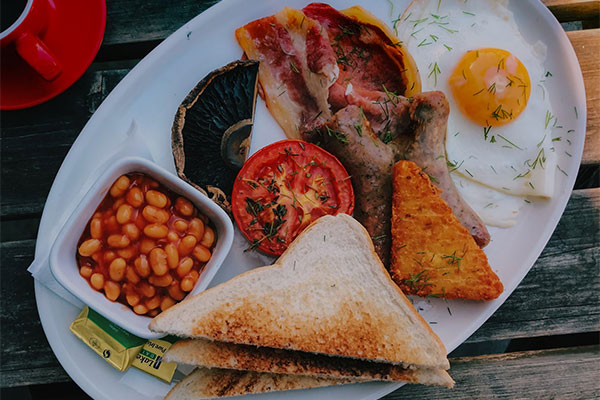
Typical dishes from Ireland and the United Kingdom
Fish and chips
No need to introduce this legendary dish of British gastronomy which has conquered palates around the world, between its fries (traditionally vinegared) and its very crispy fried fish (most often haddock or cod), without forgetting the small tartar sauce and the accompanying mashed peas. A delight!
This dish born in the 19th century, which was formerly wrapped in old newspaper, was highly popular with the working class for its low price and its comforting side. Today, he has won the hearts of all populations, British… or not! To be enjoyed in a pub or by the sea, well protected from pilfering seagulls.
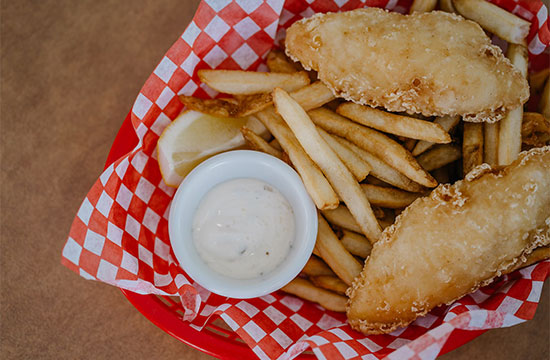
Sunday Roast
There are traditions that the British cannot deviate from, and the "Sunday roast" is one of them. Like Sunday chicken in France, this dish is served during the traditional Sunday lunch which brings together the whole family.
There is roast meat (usually beef or lamb) as well as baked potatoes, grilled vegetables and Yorkshire pudding, a kind of savoury cake inseparable from the Sunday Roast, all generously sprinkled with gravy, this sauce made from meat juice, very popular in Anglo-Saxon countries.
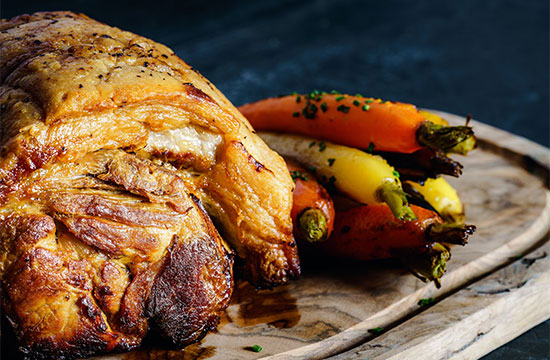
Yorkshire pudding
Although it is named after a dessert, Yorkshire pudding is in fact a savoury dish, very dear to the hearts of the English and whose recipe is passed down from generation to generation.
A sort of soufflé prepared from milk, eggs and flour, it is often found as an accompaniment to Sunday Roast (or any meat) or as a starter sprinkled with gravy, as it was formerly served: in fact, the Yorkshire pudding, due to its consistency, made it possible to satiate the guests so that they then had less room for the meat of the main course, which used to be relatively expensive. This dish originating from the north of England was once cooked over a fire with the meat roasting above.
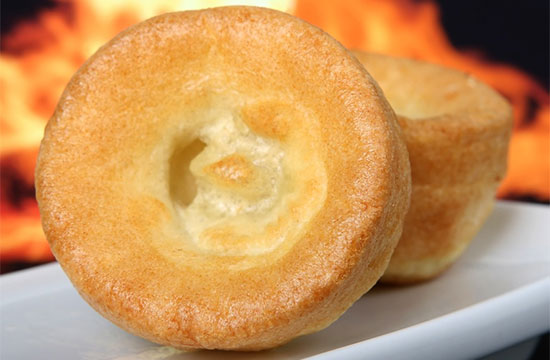
Irish stew
Irish stew, a typical Irish dish, is a stew prepared with lamb, potatoes, onions and possibly other vegetables such as carrots or turnips. This dish originated in the 19th century, when Ireland was hit by mass poverty. This economical meal based on inexpensive and easily accessible ingredients had the added advantage of being very nutritious.
Since then, Irish stew has seen its recipe evolve and diversify (you can even find dark beer (stout)). It remains one of the Irish's favourite dishes and can be enjoyed in any pub in the country.
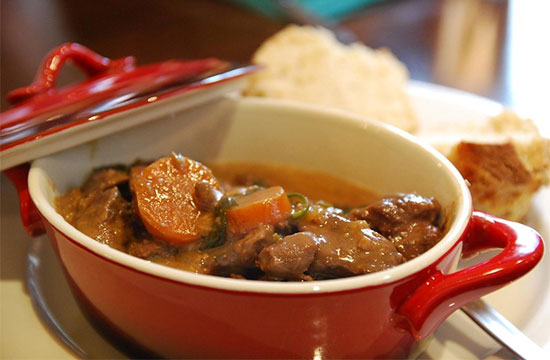
Bangers & mash
This very simple dish to prepare is composed of sausages ("bangers") and mash ("mash"), all covered with onion sauce. Although it can also be made from lamb or beef sausages, it is pork sausages that are traditionally used, and particularly those of the Cumberland variety.
Bangers & Mash became widely used at the time of the First World War, the nickname given to the sausages evoking the noise they made (bang!) when exploding during cooking due to the large quantity of water that they contained. Today, this dish, which has become a classic of British cuisine, can be found on the menu of all pubs, and in a more sophisticated version in gastropubs.
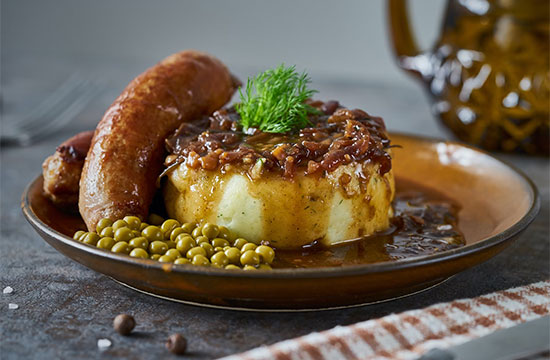
Haggis
Haggis is a traditional Scottish dish made from sheep offal, onions, oats, animal fat, salt and spices. Although it was originally cooked in a sheep's belly, this has now been replaced by a synthetic casing. So yes, haggis is not the most delicious dish in the world, but once you get past the visual aspect, it is worth the detour!
Haggis was popularized by the Scottish poet Robert Burns (he even wrote an ode to it!) and continues to be celebrated every year on Burns night, during which the Scots enjoy this very special dish accompanied by whisky. Why not let yourself be tempted by haggis too? It might surprise you...
Chicken Tikka
British cuisine today bears the traces of Indian influences (see A brief history of British cuisine) which have marked its history, proof of which is that chicken tikka masala has even become the British national dish!
Accompanied by tomato and cream sauce, more or less spicy depending on taste, chicken tikka is traditionally eaten with cheese naan and is found on the menus of many restaurants in London and throughout the United Kingdom. It is said to have been invented by a Bangladeshi chef who settled in the United Kingdom specifically to appeal to the more sensitive palates of the British and has since become an iconic dish in the country.
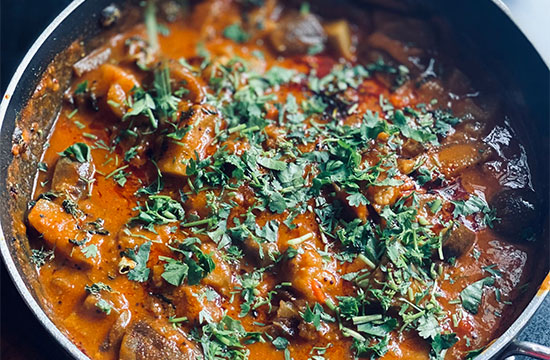
Toad in the Hole
"Toad in the Hole" is a very popular family dish in the United Kingdom, born during the Industrial Revolution in the 18th century where it was widespread among the most modest families for its economical and nourishing side.
Rest assured, unlike frog eaters in France, English are not fond of amphibians: this dish which is similar to a gratin or a savoury clafoutis is in fact composed of sausages, cooked in a paste similar to that of Yorkshire pudding. It is traditionally served with gravy sauce, vegetables and mashed potatoes, especially for dinner.
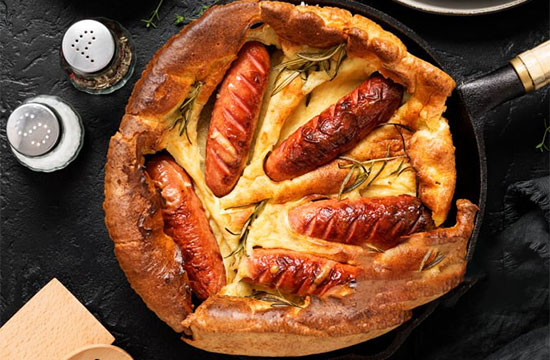
Scotch eggs
A great curiosity of British cuisine, Scotch eggs are hard-boiled eggs coated with sausage meat and breading, which are fried or cooked until they obtain a crispy envelope.
In the United Kingdom, Scotch eggs are found both at traditional picnics and on the pub menu where they are very popular as a starter or to accompany a beer during an aperitif or afterwork. Although the origin of Scotch eggs remains unclear, today we can safely say that there is nothing Scottish about them, despite what their name suggests!
Welsh Rarebit
Very simple to make and very nutritious (like most British dishes), the Welsh rarebit consists of a thick slice of bread that is toasted and to which we add a mixture based on (a lot of) cheddar, cheese. a little beer and a touch of mustard.
You can also find other ingredients such as ham, Worcestershire sauce, paprika or even an egg (you will then taste a "buck rarebit"). We put everything in the oven and we obtain an appetizing slice of bread served in pubs accompanied by a pint.
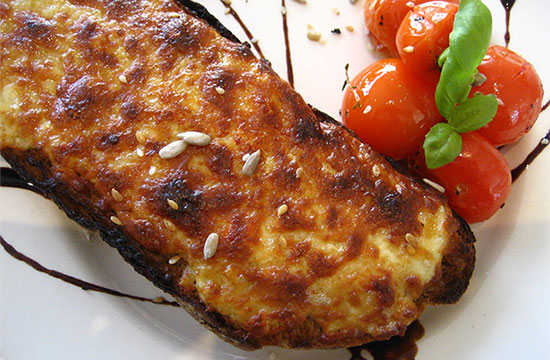
Bubble & squeak
Bubble and Squeak, whose amusing name recalls the noise it makes when cooking (bubbles and "squeaaaak"), is a dish made from vegetables, notably cabbage and potatoes, which is pan fried.
This dish, both practical and economical, allows you to finish leftovers since you can add all the "leftovers" of the week or even the Sunday Roast. The Bubble and Squeak is very similar to the Irish Colcannon that is traditionally served on Halloween night.
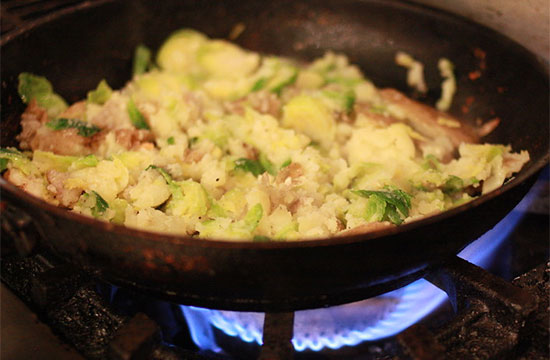
Pies
Pies are a must in overseas cuisine. Although they translate as “tart” in French, they are more similar to our French quiches and pies. They are very popular with the British who use them in many ways. The most popular is Shepherd's pie, which is made with lamb meat, mash and vegetables, with its variation Cottage pie, prepared with beef.
Other great classics: Chicken pie, a pie with chicken, mushrooms and creamy sauce, or Kidney Pie, cooked with beef and kidneys. Those who prefer fish can opt for a Fish pie, in which you can find sardines, salmon or even cod).
